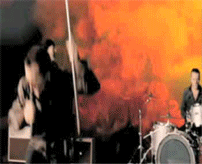Lanois’ bag of magic tracks didn’t just suddenly materialize, however. His mastery of all things ambient stems
from the early ’80s, which he spent working alongside Brian Eno on his On Land and Apollo: Atmospheres and Soundtracks
albums, as well as equally groundbreaking recordings by minimalist pianist Harold Budd, and Fourth World Music trumpeter Jon
Hassell.
Lanois has continued to work with many of these artists—mainstream and avant garde—throughout his career, as
well as scoring several films, and releasing five discs of his own thoughtful and eclectic music. On his latest album, Belladonna
[Anti], Lanois deviates from the mostly song-oriented approach of his previous solo work, and returns to his sonic roots,
creating evocative guitar and pedal steel-based instrumentals.
What role does improvisation play in your compositional process?
I always allow myself to improvise
in the studio because it’s my laboratory. I’ve been investigating sonics since I was a kid, so I’m continually
excited about them, and there are always new tools to work with. I don’t try to embrace too many tools at once, though,
because while I might become knowledgeable about them all, I may not master any of them. So, I’ll improvise until I
find that little moment that has something special about it—I think of them as sonic pure forms—and then I’ll
build a piece of music around it. Oftentimes, those pieces lead to something I’ve never done before, and that’s
what interests me most.
So, your pieces typically begin as improvisations inspired by technology?
Some of them do. For example,
the song “Telco” on Belladonna began as an angst-driven 20-minute improvisation played on a Les Paul through a
Boomerang looping pedal. The first part of it was really compelling, so I found my favorite three minutes, and then I built
an arrangement by layering piano and other melodies on top. I’m also a tunesmith, however, and other pieces of music
begin with melodies. They aren’t improvised at all.
How did the desert serve as an inspiration for Belladonna?
Some years ago, I spent time in
a little mountaintop village outside of Oaxaca, Mexico, and fell in love with the tranquility and the culture. Suddenly, the
sound of a fly zipping by my ear was the loudest thing I could hear, and that really altered my perspective and opened up
my imagination. But that place was too isolated to bring equipment to, so I recorded in a Baja desert town called Todo Santos.
Anyone
who has spent time in the desert beyond being a tourist can begin to understand what the healing process of psychedelics might
be all about, and some of that made its way into this music, which is why I called it Belladonna. Should you eat
a little piece of this flower, you will go on a psychedelic journey, and I thought it would be nice if music held that kind
of power. I tried to reach a place where I could tempt the listener into entering the world of psychedelics without actually
taking drugs.
How did you translate that desire into music?
I’ve always found that roots and geography play
a role in the music you make. By roots, I mean the music you grew up listening to, your friends, what turned you around as
a teenager, and so on. And by geography, I mean that where you work influences what you do—particularly the space you
record in. When I walk into a room, I sense right away what can happen there.
For example, U2’s Achtung Baby!
was recorded in Berlin at the same studio that Iggy Pop and David Bowie used in the ’70s. It was cold and miserable,
but we wanted to be in that room because there was something coming out of the walls that we could feel. Another example is
the record I made with Emmylou Harris. I wanted to record in a big square room—like the old studios the BBC used to
record live sessions for radio and television—so we scoured the whole of Nashville until we found Woodland Studios,
and Wrecking Ball has the sound of that room.
Do you use ambient microphones to capture the sound of the room?
No. If you’re recording a bunch
of people in a room at once you get ambient mics anyhow—especially if you’re doing live vocals, as was the case
with Wrecking Ball, and also with Bob Dylan’s Time Out of Mind. You get a certain kind of excitement and a natural depth
of field, because when somebody is further back in the room they sound further back. This is because they’re leaking
into the front microphone.
You sometimes say that your job as a producer is to “raise the spirit.”
That’s just
another way of saying “get it right.” Because what we love about records is that they get us out of our skins
and provide an opportunity to be elevated. Everyday life is sweet but humdrum, and what we love about art is that it gives
us a chance to look at life in a different way. When I go home and put on Stan Getz’s Bossa Nova—Jazz ’Round
Midnight, I feel good right away. It’s a beautiful record, and it makes me want to have a lovely evening.
When working with an artist, how do you get them to that place?
Brainstorming and philosophizing are
essential, because you can’t make a good record without knowing what your passions are. When I made Time Out Of Mind
with Bob Dylan, we got together and he read me the lyrics to the entire album. Afterward, he asked me if I thought we had
a record, and I said, “Yes”—even though I hadn’t heard a note. Then he asked me do some homework by
listening to about a half-dozen old records that he liked the sound of—tracks that had unfolded at the front end of
the medium when the waters had not yet been fully explored. That freshness fascinated Bob.
So I took it very seriously.
I went to the studio of a friend of mine, and we played along with the records, and even recorded on top of them. Then we
found the magic few bars where we had done something special, and we looped them. Bob and I recorded some demos on top of
those loops, and that was the beginning of the album.
Some of your most successful collaborations as both co-producer and artist have been with Brian Eno. What do you
each bring to the party that the other needs?
Brian has those great English characteristics of patience and the
dedication to tinkering. That’s why they build the best bicycles in England. It’s largely about being methodical
and sitting there long enough, taking notes, writing down parameters, and slowly building something unique. I have a soul
barometer, and an understanding of when something feels good, so I operate more at the emotional end of the spectrum rather
than being a scientist.
And it’s a good marriage, because as the French one I will sometimes recognize when I’ve
gotten to the right place, but I’ll forget how I got there, whereas the scientist will remember exactly how he got there.
And that’s good, because it means that you can replicate something if you didn’t quite get it right. That’s
largely what our partnership is about.
What advice would you give to a young artist trying to find his or her own voice?
Finding your own
voice is the opposite of being inspired by your heroes, and there’s no technique for that. Find some little thing that
you think is unique to you—like a melody that you whistle all the time, but don’t know where it came from—and
build on it, even if it doesn’t seem like much at first. It may not be Stravinsky yet, but it could be.

